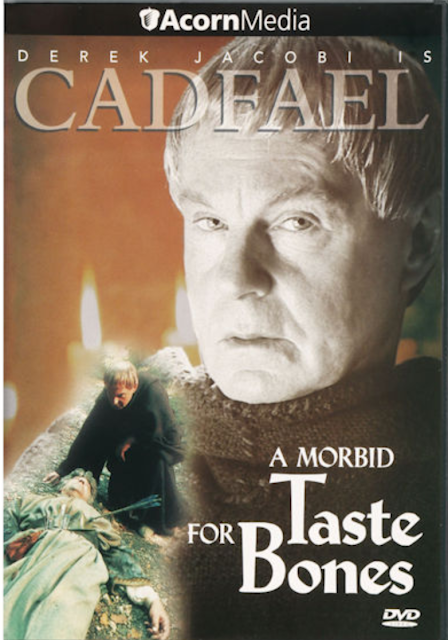Welcome back to our winter movie series, in which plants are the real movie stars! This winter we're enjoying several episodes from Cadfael, the British drama series that is based on the books by Edith Pargeter, also known as Ellis Peters. The series is set in medieval England in the early 1100s, and takes place in the fictional Shrewsbury. Brother Cadfael is a Benedictine monk in the Abbey of Saint Peter and Saint Paul, and works in his garden and medicinal shed to prepare botanical remedies. He joined the monastery later in life, after serving in the Crusades, and is often called upon to use his logic, experience, and plant knowledge to solve local mysteries.
Prior Robert Pennant feels called to collect the remains of Saint Winifred from Wales and bring them to the Abbey of Saint Peter and Saint Paul, where they will be better cared for and revered. Brother Columbanus, a young and ambitious monk, sees visions and communicates with Winifred in his reverie, which seems to support the prior's mission. The prior and several monks set out for Gwytherin, where Saint Winifred has been buried for hundreds of years, to collect her bones. Brother Cadfael is ordered to travel with them since he is Welsh and may be an asset. He does so reluctantly as he sees more human ambition (the benefits of a relic in their abbey) than a divine mission.
At Gwytherin the monks receive hospitality from the local parish priest, but resistance from the villagers. When Rhisiart (a wealthy landowner and vocal critic of moving Saint Winifred) is found murdered, Brother Cadfael is given three days to catch the killer and convince the villagers to relinquish Saint Winifred. A key clue is a missing dose of poppy juice, which Brother Cadfael uses to relieve pain. Cadfael sorts through all the passions, motives, and intrigues of the suspects to identify the killer and bring a satisfying resolution.
This brings our winter movies series to an end for 2020. I hope you've enjoyed these episodes of Cadfael, as we wait out the cold, dark days of winter for the warm, productive days of spring ahead. I've really enjoyed seeing Brother Cadfael working in his garden and medicinal shed, and solving mysteries using his plant knowledge. It's interesting to note the "useful" nature of the garden at this time, to grow produce, cultivate orchards, and provide medicinal herbs that are used in healing. To learn more about medieval gardens and their place in gardening history, see Garden History – Medieval Gardens and Elements of the Medieval Garden. Useful gardens are one of the many stepping stones through time that have brought us to the modern gardens of today.
A Morbid Taste for Bones (Season 2, Episode 3)
Prior Robert Pennant feels called to collect the remains of Saint Winifred from Wales and bring them to the Abbey of Saint Peter and Saint Paul, where they will be better cared for and revered. Brother Columbanus, a young and ambitious monk, sees visions and communicates with Winifred in his reverie, which seems to support the prior's mission. The prior and several monks set out for Gwytherin, where Saint Winifred has been buried for hundreds of years, to collect her bones. Brother Cadfael is ordered to travel with them since he is Welsh and may be an asset. He does so reluctantly as he sees more human ambition (the benefits of a relic in their abbey) than a divine mission.
At Gwytherin the monks receive hospitality from the local parish priest, but resistance from the villagers. When Rhisiart (a wealthy landowner and vocal critic of moving Saint Winifred) is found murdered, Brother Cadfael is given three days to catch the killer and convince the villagers to relinquish Saint Winifred. A key clue is a missing dose of poppy juice, which Brother Cadfael uses to relieve pain. Cadfael sorts through all the passions, motives, and intrigues of the suspects to identify the killer and bring a satisfying resolution.
This brings our winter movies series to an end for 2020. I hope you've enjoyed these episodes of Cadfael, as we wait out the cold, dark days of winter for the warm, productive days of spring ahead. I've really enjoyed seeing Brother Cadfael working in his garden and medicinal shed, and solving mysteries using his plant knowledge. It's interesting to note the "useful" nature of the garden at this time, to grow produce, cultivate orchards, and provide medicinal herbs that are used in healing. To learn more about medieval gardens and their place in gardening history, see Garden History – Medieval Gardens and Elements of the Medieval Garden. Useful gardens are one of the many stepping stones through time that have brought us to the modern gardens of today.

No comments:
Post a Comment